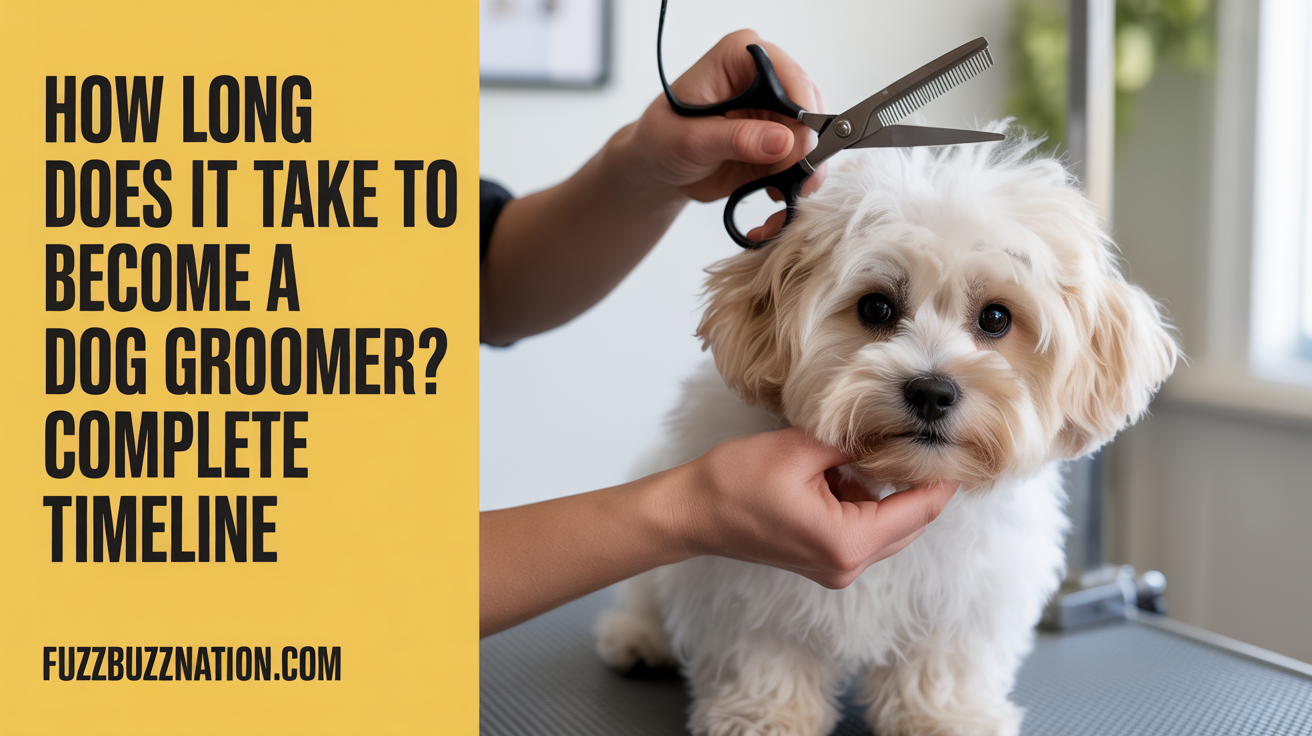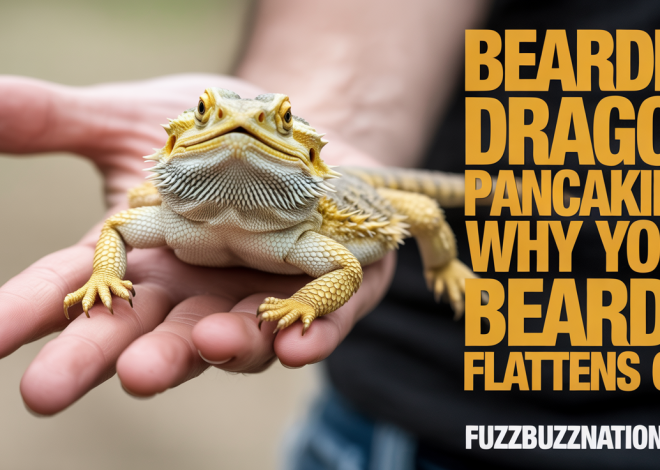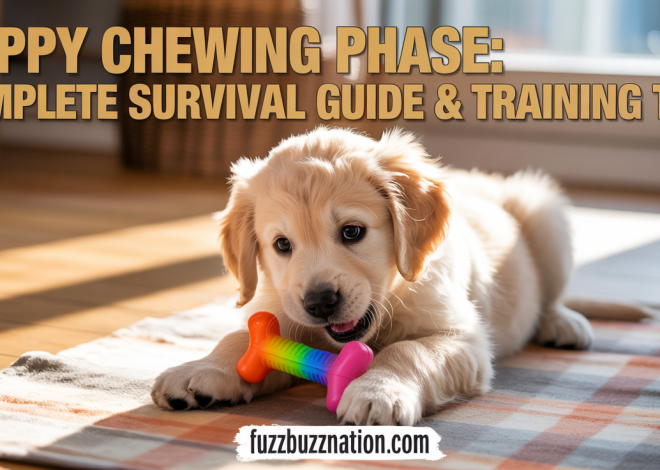
How Long Does It Take to Become a Dog Groomer?
Becoming a professional dog groomer typically takes 6-12 months through formal grooming school programs or 1-2 years through apprenticeship training, though achieving true proficiency and confidence handling all breeds requires 2-3 years of hands-on experience. After working as a professional groomer for eleven years and training over 30 apprentice groomers during my career, I’ve learned that while basic skills can be learned relatively quickly, mastering the craft requires consistent practice with diverse breeds, developing speed without sacrificing quality, and building the physical stamina and business knowledge that separate hobbyists from successful professional groomers.
The key to understanding grooming career timelines lies in recognizing that multiple training paths exist with varying time commitments, initial certification doesn’t equal mastery, and your chosen specialization and work setting significantly impact how quickly you can build a sustainable grooming career.
Understanding Different Training Paths
Formal Grooming School Programs
Professional grooming schools offer structured programs ranging from 2-6 months of intensive training covering all aspects of dog grooming from basic bathing to breed-specific styling.
During my training at a 16-week grooming academy, I spent 30-40 hours weekly learning practical grooming skills, safety protocols, breed standards, and business fundamentals preparing me for entry-level positions.
These programs provide concentrated learning with experienced instructors, immediate feedback on technique, and exposure to multiple breeds that would take much longer to encounter through on-the-job training alone.
Tuition costs range from $5,000-15,000 depending on program length, location, and included tools, representing significant upfront investment but potentially faster career entry than alternative paths.
Apprenticeship and On-the-Job Training
Apprenticeships involve working under experienced groomers, starting with basic tasks like bathing and brushing before gradually progressing to full grooming responsibilities over 1-2 years.
I’ve trained numerous apprentices who started as bathers earning minimum wage and progressed to full grooming positions within 12-18 months, learning through supervised practice with real clients.
This path requires minimal upfront costs as employers typically provide training, though income during the learning period remains lower than certified groomers and advancement depends heavily on mentor quality.
The gradual skill building through apprenticeship often produces confident groomers comfortable with various breeds and temperaments, though knowledge gaps may exist without formal education in anatomy, safety, or business practices.
Self-Teaching and Online Courses
Online grooming courses and instructional videos allow flexible, self-paced learning at lower costs than formal schools, though they lack hands-on practice and direct feedback essential for skill development.
Through observing self-taught groomers entering the profession, I’ve noticed that theoretical knowledge from videos doesn’t translate easily to actual dogs, with most requiring additional mentoring or coursework to fill practical skill gaps.
This path works best as supplemental education for already-working groomers seeking specific skills rather than primary training for complete beginners without any grooming experience.
Time to proficiency through self-teaching varies dramatically from 2-3 years depending on learning resources, access to practice dogs, and natural aptitude for the physical and technical aspects of grooming.
Combination Approaches
Many successful groomers combine formal education with apprenticeship, attending grooming school for foundational skills then working under experienced groomers to build speed, efficiency, and client-handling abilities.
I used this approach myself, completing a 4-month program then working as an assistant groomer for 6 months before taking on my own full client load, finding the combination provided both theoretical knowledge and practical application.
This hybrid path typically takes 10-18 months to reach independent grooming capability while offering benefits of structured education and real-world experience under supervision.
Detailed Timeline Breakdown
Months 1-3: Foundation Skills
Initial training focuses on safety protocols, equipment familiarization, basic bathing techniques, nail trimming, and ear cleaning that form the foundation for all grooming work.
During my first three months, I practiced extensively on cooperative dogs, learning proper restraint techniques, recognizing stress signals, and developing the physical stamina required for hours of standing and repetitive motions.
Students learn to identify common skin conditions, parasites, and health concerns requiring veterinary attention, as groomers often serve as first-line observers of dog health issues.
Tool maintenance including clipper blade sharpening, scissors cleaning, and equipment troubleshooting becomes second nature through daily practice and instructor supervision during this foundational period.
Months 4-6: Basic Grooming Techniques
Mid-program training introduces clipper work on simple breeds, basic scissoring techniques, and complete grooming procedures from start to finish under close supervision.
I spent this period learning breed-specific cuts for popular dogs including Poodles, Bichons, and Cocker Spaniels, initially requiring 3-4 hours per dog before gradually improving speed.
Hand stripping techniques for wire-coated breeds, Asian Fusion styling, and creative grooming are introduced for students interested in specialized work beyond basic pet grooming services.
Student confidence builds as they complete more dogs independently, though speed and efficiency remain slow compared to experienced professionals who can groom 4-6 dogs daily.
Months 7-12: Building Speed and Proficiency
Post-graduation or advanced apprenticeship work focuses on increasing grooming speed while maintaining quality, with most new groomers initially completing 2-3 dogs daily.
During my first year as a professional groomer, I gradually increased my capacity from 3 dogs to 5-6 dogs daily as my skills became more automatic and efficient.
Difficult dogs including aggressive, anxious, or matted animals challenge new groomers, requiring patience, creative problem-solving, and sometimes assistance from more experienced team members.
Client communication skills develop as new groomers learn to manage expectations, educate owners about maintenance, and handle complaints or concerns professionally.
Years 2-3: Achieving Mastery
True proficiency arrives when groomers can confidently handle any breed, temperament, or grooming challenge while maintaining consistent speed and quality across their workday.
I reached this milestone around year 2, feeling genuinely competent with diverse breeds and situations, no longer anxious about scheduling difficult dogs or encountering unexpected challenges.
Specialization opportunities emerge as experienced groomers develop reputations for specific skills including show grooming, creative styling, or handling anxious dogs that command premium pricing.
Business skills including marketing, pricing strategy, and client retention become crucial for groomers transitioning from employee positions to independent businesses or mobile grooming services.
Factors That Affect Training Duration
Natural Aptitude and Physical Abilities
Manual dexterity, artistic eye, and physical stamina significantly impact learning speed, with naturally skilled individuals progressing faster than those requiring more practice to develop these abilities.
Through training diverse students, I’ve observed that previous experience with dogs, art backgrounds, or careers requiring fine motor skills typically accelerate learning compared to complete beginners.
Physical demands including standing 8+ hours daily, repetitive hand motions, and lifting large dogs require fitness and injury prevention strategies that some individuals adapt to more quickly than others.
Practice Frequency and Volume
Students grooming daily learn exponentially faster than those practicing sporadically, with hands-on experience being the primary driver of skill development in this tactile profession.
I credit my rapid progression to grooming 4-5 dogs daily during training, accumulating diverse experience quickly compared to part-time students taking twice as long for equivalent skill development.
Access to practice dogs through volunteer work, personal pets, or employed positions provides critical hands-on time accelerating learning beyond what classroom instruction alone can achieve.
Mentor Quality and Support
Experienced mentors who provide constructive feedback, demonstrate advanced techniques, and create supportive learning environments dramatically accelerate apprentice development compared to sink-or-swim approaches.
During my apprenticeship, I benefited from a patient mentor who explained her techniques, answered questions without judgment, and gradually increased my responsibilities as skills improved.
Poor mentorship through impatient or unavailable supervisors leaves apprentices struggling to learn from mistakes, extending training periods and potentially developing bad habits requiring correction later.
Breed Exposure and Variety
Exposure to diverse breeds accelerates learning as groomers encounter different coat types, temperaments, and grooming requirements that build versatile skill sets applicable across all dogs.
I gained confidence quickly by grooming at a busy salon seeing 15-20 different breeds weekly, compared to groomers in limited markets repeatedly grooming the same breeds.
Specialized operations focusing on specific breeds like Poodles develop deep expertise quickly but may leave groomers unprepared for other breeds if transitioning to general practice later.
Certification and Licensing Requirements
State and Local Regulations
Most U.S. states don’t require formal grooming licenses or certifications, allowing anyone to legally operate as a groomer regardless of training, though some municipalities impose local regulations.
Through working across multiple states, I’ve found that lack of regulation means buyer beware for pet owners, emphasizing the importance of voluntary certification demonstrating professional standards.
Some states require business licenses, facility inspections, or liability insurance for grooming operations regardless of whether individual groomer certification is mandated.
Voluntary Professional Certifications
National Dog Groomers Association of America (NDGAA) and International Professional Groomers (IPG) offer voluntary certifications requiring written exams and practical demonstrations of grooming skills.
I earned my certification after two years of professional experience, finding the process validated my skills and provided marketing advantages through demonstrated competency to potential clients.
Certification typically requires 200-300 hours of professional grooming experience plus passing breed-specific practical tests and written exams covering safety, anatomy, and grooming standards.
The certification process takes additional months beyond initial training, with many groomers waiting 1-2 years to gain sufficient experience before attempting certification exams.
Continuing Education
Professional development through workshops, seminars, and advanced training courses helps experienced groomers stay current with trends, techniques, and tools throughout their careers.
I attend 2-3 educational events yearly, finding that continuous learning keeps skills sharp and exposes me to new approaches that improve efficiency and quality.
Specialty certifications in areas like pet first aid, cat grooming, or creative styling enhance marketability and allow groomers to command higher prices for specialized services.
Cost Considerations for Training
Formal Education Expenses
Grooming school tuition ranges from $5,000-15,000, with additional costs for tools ($500-1,500), supplies ($200-500), and living expenses during full-time training programs.
During my training, I spent approximately $10,000 total including tuition, tools, and transportation, financed through personal savings and student loans repaid from grooming income.
Some schools offer payment plans or financial aid, though grooming education typically doesn’t qualify for federal student loans available for traditional college programs.
Tool quality significantly impacts initial investment, with professional-grade clippers, scissors, and equipment lasting decades versus cheap alternatives requiring frequent replacement.
Apprenticeship Financial Impact
Apprentices typically earn $10-15 hourly during training periods, significantly less than certified groomers earning $15-25+ hourly plus commission on services performed.
I calculated that apprenticeship cost me approximately $15,000 in lost income over 12 months compared to if I’d been earning certified groomer wages immediately.
However, the employer-provided training and tools eliminated $5,000-10,000 in education costs, making apprenticeship economically competitive with formal school despite lower training-period income.
Living expenses during 1-2 year apprenticeships can be challenging for individuals unable to support themselves on entry-level wages, potentially extending training as people work second jobs.
Return on Investment Timeline
Most groomers recoup training investments within 1-2 years of full-time professional grooming, with earnings potential ranging from $25,000-60,000 annually depending on location and business model.
Through tracking my finances, I broke even on training costs within 18 months of graduation, then began building savings and eventually starting my own mobile grooming business.
Mobile groomers and business owners can earn $50,000-80,000+ annually after establishing clientele, though startup costs for vehicles and equipment require additional investment beyond initial training.
Building a Sustainable Grooming Career
Entry-Level Positions
New groomers typically start at established salons or pet stores, gaining experience while learning business operations, client management, and maintaining consistent work schedules.
My first position paid $12 hourly plus 20% commission, providing steady income while building skills and clientele that eventually supported my transition to independent work.
Corporate groomers at Petco or PetSmart offer benefits, consistent hours, and ongoing training opportunities, though pay and creative freedom may be limited compared to independent salons.
High-volume operations provide extensive dog exposure accelerating skill development but can lead to burnout from pressure to maintain fast grooming speeds with less attention to detail.
Developing Your Client Base
Building a loyal client base takes 1-2 years of consistent quality work, professional communication, and reliability that earns referrals and repeat business essential for sustainable income.
I focused on exceeding expectations, maintaining detailed client notes, and sending appointment reminders that helped me develop a full schedule within 18 months of starting.
Social media presence through before/after photos, educational content, and client testimonials builds reputation and attracts new customers in today’s digital marketing environment.
Career Advancement Opportunities
Experienced groomers can advance to salon management, open independent businesses, start mobile grooming services, or specialize in show grooming commanding premium prices.
After five years as an employee groomer, I started my mobile grooming business, investing $35,000 in a used grooming van that allowed me to double my income within two years.
Competition grooming showcases skills at regional and national events, building reputation and credibility that attracts clients seeking top-tier grooming services.
Education and mentoring opportunities allow experienced groomers to teach workshops, train apprentices, or develop online courses creating additional income streams beyond hands-on grooming.
Physical Demands and Career Longevity
Common Injuries and Prevention
Repetitive strain injuries including carpal tunnel, back pain, and shoulder problems affect many groomers, requiring ergonomic practices, strength training, and regular breaks.
During my career, I’ve developed several strategies including proper table height, anti-fatigue mats, and regular stretching that have prevented serious injuries affecting many colleagues.
Grooming gloves protect hands from scissor blisters and repetitive motion strain, while proper lifting techniques prevent back injuries when handling large dogs onto tables.
Dog bites and scratches occur occasionally despite careful handling, requiring current tetanus vaccination and first aid knowledge for treating minor injuries promptly.
Maintaining Career Longevity
Successful long-term groomers manage their schedules to prevent burnout, limiting daily dog numbers to sustainable levels that preserve physical and mental health over decades.
I now groom 4-5 dogs daily instead of the 6-8 I managed in my twenties, prioritizing quality and sustainability over maximum income that would lead to premature career end.
Diversifying income through product sales, teaching, or consulting reduces physical grooming hours while maintaining income levels supporting comfortable lifestyles.
Planning for eventual retirement through business sale, transitioning to less physical roles, or developing passive income streams helps groomers prepare for physical limitations.
Frequently Asked Questions
Can I become a dog groomer without going to school?
Yes, many successful groomers learn through apprenticeships, mentorship, or self-teaching combined with volunteer experience. However, formal education typically accelerates learning and provides comprehensive knowledge that on-the-job training might miss. Self-taught paths take longer (2-3 years vs 6-12 months for school graduates) and require significant self-discipline and access to practice dogs. Some employers prefer or require formal grooming school certificates, potentially limiting job opportunities for self-taught groomers despite equivalent skills.
How much money can I make as a dog groomer?
Entry-level groomers earn $25,000-35,000 annually, experienced salon groomers make $35,000-50,000, and independent or mobile groomers can earn $50,000-80,000+ depending on location, clientele, and business model. Commission structures, tips, and retail sales supplement base wages significantly. Geographic location dramatically affects earnings, with groomers in high-cost urban areas commanding higher prices than rural markets. Building a full client base takes 1-2 years, with income increasing substantially as reputation and efficiency improve.
Is dog grooming a good career choice?
Dog grooming offers a rewarding career for animal lovers with artistic abilities and physical stamina, providing job security in a growing industry resistant to economic downturns. The work combines creativity with practical skills, offers flexible scheduling opportunities, and allows independent business ownership without extensive education requirements. However, the physically demanding nature, relatively modest income compared to some professions, and emotional challenges of handling difficult dogs or clients make it unsuitable for everyone. Success requires genuine passion for working with animals and commitment to continuous skill development.
Do I need to be certified to groom dogs?
Most states don’t require certification or licensing to work as a professional groomer, though some municipalities have local regulations. Voluntary certification through organizations like NDGAA or IPG demonstrates professional competency, potentially increasing job opportunities and client trust. Many successful groomers operate without formal certification, though employers may prefer certified candidates. Certification typically requires 200-300 hours of experience plus passing practical and written exams, adding several months beyond initial training timelines.
How physically demanding is dog grooming?
Dog grooming is highly physical work requiring standing 6-8+ hours daily, repetitive hand motions, lifting dogs weighing up to 100+ pounds, and maintaining awkward positions during grooming. The work causes strain injuries including carpal tunnel, back pain, and shoulder problems in many groomers. Physical demands often limit career longevity to 15-20 years unless groomers adopt ergonomic practices, manage workload, and maintain fitness. Anyone considering grooming should honestly assess their physical capabilities and willingness to implement injury prevention strategies for long-term career sustainability.
Making Your Decision
Becoming a dog groomer requires realistic expectations about training duration, physical demands, and financial investment needed to build a sustainable career in this rewarding but challenging profession.
Choose training paths matching your learning style, financial situation, and timeline for career entry, recognizing that multiple routes can lead to successful grooming careers with different advantages and trade-offs.
Commit to continuous learning throughout your career, as grooming techniques, breed trends, and business practices evolve constantly requiring ongoing education for professional relevance.
Remember that initial training provides foundational skills only, with true mastery developing over years of diverse hands-on experience handling various breeds, temperaments, and grooming challenges that classroom instruction cannot fully replicate.


